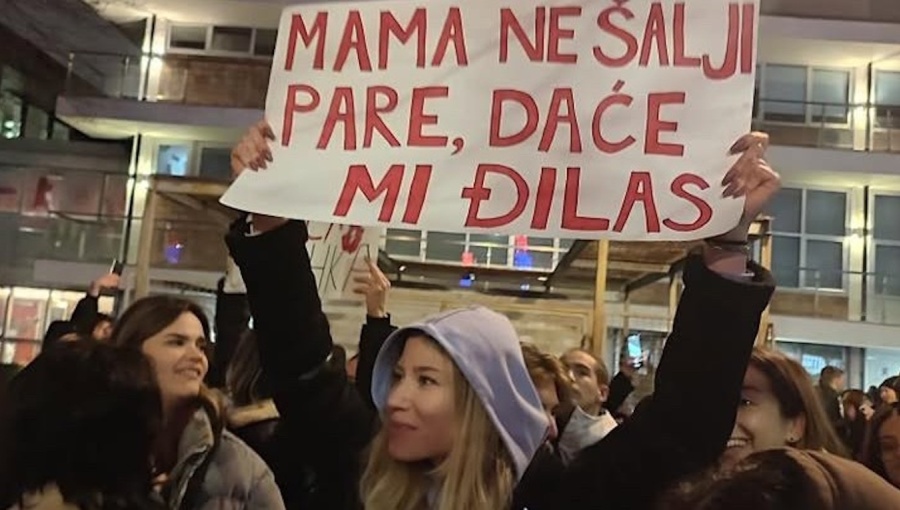Mass Protests in Serbia: A Call for Justice
Tragedy Sparks Nationwide Unrest
Serbia is witnessing unprecedented mass protests as citizens demand justice and accountability following the catastrophic collapse of a railway station canopy that resulted in the loss of 15 lives. The tragic incident, which occurred on November 1 during a renovation effort managed by two Chinese companies, has ignited widespread outrage throughout the country.
Student Activism and Widespread Solidarity
For nearly three months, tens of thousands of college students have taken to the streets, advocating for justice for the victims and calling for accountability for those responsible for the disaster. The situation escalated last week when a general strike was declared, prompting workers to walk off their jobs, major streets in Belgrade to be blocked, and university campuses to be occupied in support of the young protestors.
Professor Tanya Domi, who has worked in the Balkans for three decades, remarked in an interview with Fox News Digital, “I’ve never seen anything like this.”
Political Fallout and Resignations
The protests have already led to significant political consequences, highlighted by the resignation of Serbian Prime Minister Milos Vucevic, marking him as the highest-ranking official to step down in response to public pressure. The mayor of Novi Sad, where the tragedy occurred, also resigned amidst the growing outcry.
“The protests have already claimed two significant political figures, and I believe there will be more to come,” said Domi, indicating that political turmoil is far from over.
Protesters Demand More Than Just Resignations
Despite these high-profile resignations, protesters have continued to demonstrate across Belgrade and beyond, insisting that the resignation of the prime minister is insufficient. Helena Ivanov, a senior fellow at the Henry Jackson Institute, stated, “The resignation of the prime minister is simply not enough.” She further emphasized that the students have specific demands, including full transparency regarding the circumstances leading to the collapse and accountability for the lives lost.
Government’s Response: A Misstep?
The government’s reaction has largely been viewed as inadequate and has failed to quell public anger. Initially ignoring the protests, authorities later reverted to more aggressive tactics, accusing demonstrators of being influenced by foreign agitators. Critics argue that these actions reveal deeper issues of systemic corruption within Serbian institutions. “For protesters, the Novi Sad railway station canopy collapse cannot be treated as a singular event,” noted Sinisa Vukovic, director of the global policy program at Johns Hopkins University. “Instead, it is a symptom of systemic negligence and corruption that culminated in this tragedy.”
The Future of Serbian Politics
As Serbia grapples with this crisis, the political future remains uncertain. With the potential for a new prime minister to be appointed within 30 days, the country could face snap elections if this does not happen. President Aleksandar Vucic has indicated he will make a decision on calling for elections within the next ten days, a move that some say may be pivotal for his regime. “This is the most significant challenge to Vucic’s rule in the 13 years of his leadership,” Ivanov stated.
Government’s Commitment to Stability
Amidst the chaos, Serbian Foreign Minister Marko Djuric has expressed a commitment to stability and reform. In an interview with Fox News Digital, Djuric assured, “We are listening, we are learning, and we are determined to ensure Serbia moves forward on its path of economic and democratic development.” However, skepticism remains regarding the government’s real commitment to enacting change.
The Role of Student Protesters
The student-led protests, while significant, are notably independent of Serbia’s established opposition parties, which are widely perceived as weak and ineffective. Protesters maintain that this is “their fight,” a movement that is not co-opted by political entities, which helps bolster their credibility and gain broader public support.
“After 13 years of one individual dominating Serbian politics and governmental institutions failing to function effectively, these protests are a clear demand for institutional change and accountability,” emphasized Ivanov.
Intensifying Clashes
As demonstrations continue, security forces have heightened their efforts to suppress the unrest, which has only served to intensify public anger and draw more citizens to the streets.
Geopolitical Tensions
Ivana Stradner, a research fellow at the Foundation for the Defense of Democracies, cautioned that President Vucic’s alignment with countries like China, Iran, and Russia may pose a threat to U.S. interests. She described his governance as an attempt at a precarious geopolitical balance: “Vucic’s domestic propaganda paints the U.S. as an enemy. With allies like him, Washington doesn’t need enemies.”
The Rising Tide of Change
As Serbia endures this internal upheaval, the protesters’ unwavering demand for accountability and reform underscores a significant challenge to Aleksandar Vucic’s long-standing political dominance. Whether this movement will achieve its goals remains to be seen, but for many, it signifies a critical juncture in Serbia’s political scenario.
